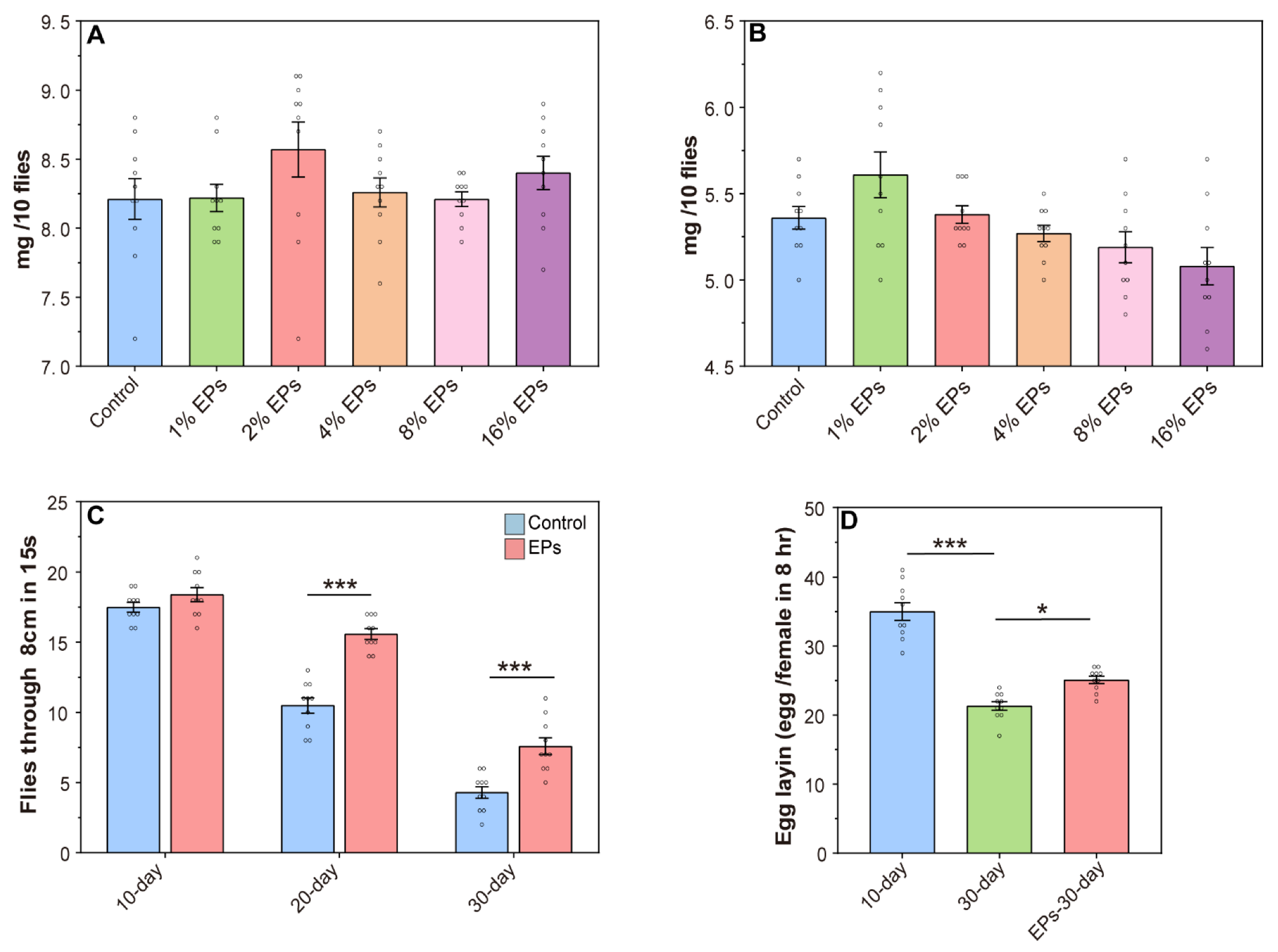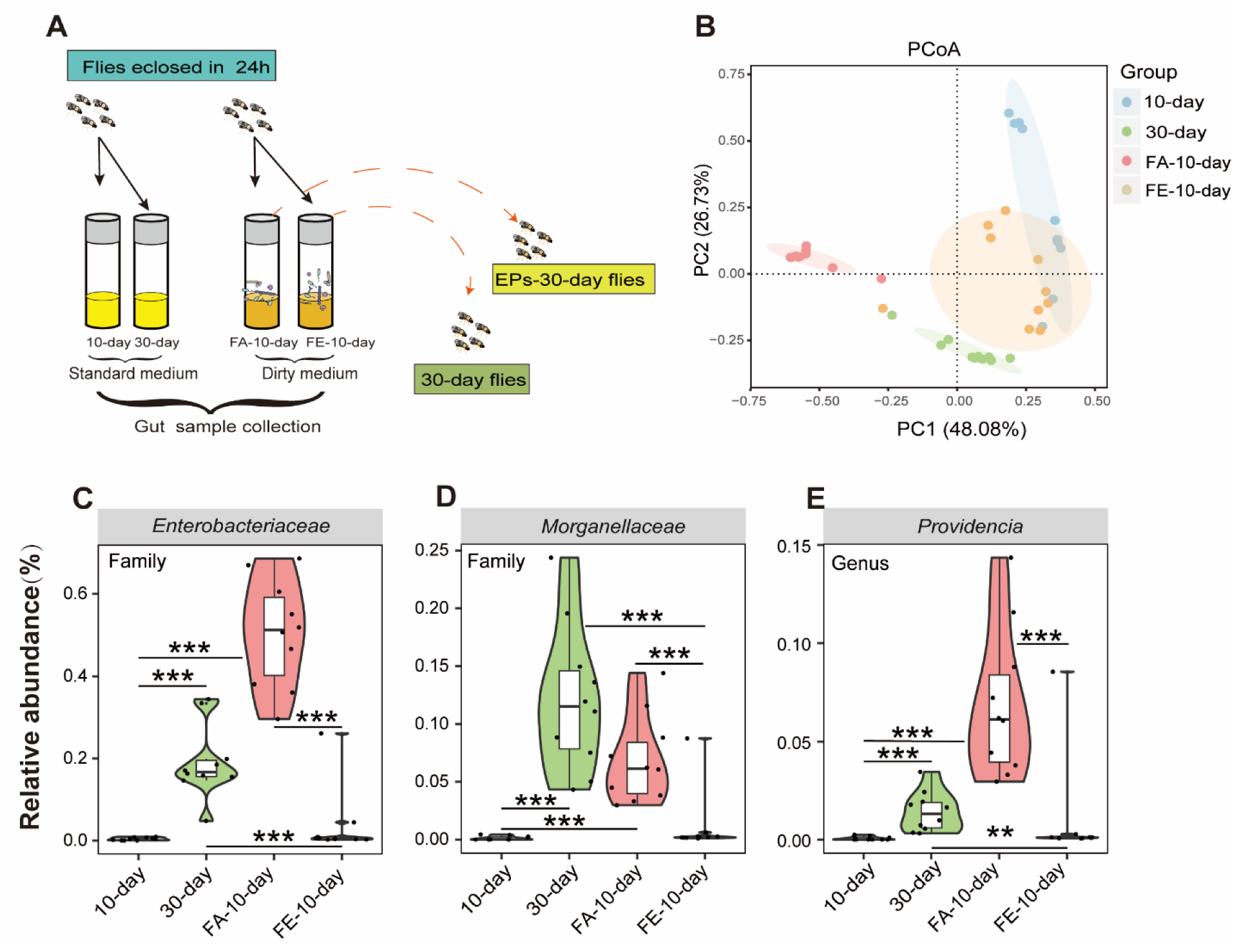Eucommia Polysaccharides Ameliorate Aging-Associated Gut Dysbiosis: A Potential Mechanism for Life Extension in Drosophila
Abstract
1. Introduction
2. Results
2.1. Morphology, Monosaccharide Composition, and Molecular Weight of EPs
2.2. Supplementation of EPs with a Proper Concentration Extended the Life Span of Drosophila
2.3. Supplementation of EPs Promotes Locomotor Activity and Fecundity in Old Flies
2.4. EPs Reduced the Oxidative Stress of Aged Drosophila
2.5. EPs Selectively Suppressed Gluconobacter, Providencia, and Enterobacteriaceae, the Main Bacterial Source of ROS from the Microbiome in Aged Drosophila
2.6. Association between the Life-Extending Effect and Gut Microbiota of EPs in Drosophila
2.7. FMT of the 30-Day-Old Flies from the EP Groups has a Similar Effect on the Gut Microbiota as EPs
3. Discussion
4. Materials and Methods
4.1. Preparation of EPs
4.2. Characterization of EPs
4.3. Drosophila Stocks and Culture
4.4. EPs Supplementation and Antibiotic Treatments
4.5. Assays of Life Span, Body Weight, and Egg-Laying
4.6. Locomotor Activity
4.7. Assays of Antioxidant Enzyme Activity
4.8. Midgut and Hindgut Dissection
4.9. ROS Measurement
4.10. DNA Extraction and PCR Amplification and Sequencing
4.11. Sequencing and Analysis of 16S rRNA
4.12. Mass Spectrometry Measurement and Quantitative Proteomic Analysis
4.13. Statistical Analysis
Author Contributions
Funding
Institutional Review Board Statement
Informed Consent Statement
Data Availability Statement
Acknowledgments
Conflicts of Interest
References
- Parker, A.; Romano, S.; Ansorge, R.; Aboelnour, A.; Le Gall, G.; Savva, G.M.; Pontifex, M.G.; Telatin, A.; Baker, D.; Jones, E.; et al. Fecal microbiota transfer between young and aged mice reverses hallmarks of the aging gut, eye, and brain. Microbiome 2022, 10, 68. [Google Scholar] [CrossRef] [PubMed]
- Blazes, M.; Lee, C.S. Understanding the Brain through Aging Eyes. Adv. Geriatr. Med. Res. 2021, 3, e210008. [Google Scholar] [PubMed]
- Nicoletti, C. Age-associated changes of the intestinal epithelial barrier: Local and systemic implications. Expert Rev. Gastroenterol. Hepatol. 2015, 9, 1467–1469. [Google Scholar] [CrossRef] [PubMed]
- Abdi, K.; Ben Said, M.; Crotti, E.; Masmoudi, A.S.; Cherif, A. The promise of probiotics in honeybee health and disease management. Arch. Microbiol. 2023, 205, 73. [Google Scholar] [CrossRef]
- Neophytou, C.; Pitsouli, C. Biotin controls intestinal stem cell mitosis and host-microbiome interactions. Cell Rep. 2022, 38, 110505. [Google Scholar] [CrossRef] [PubMed]
- Yamashita, K.; Oi, A.; Kosakamoto, H.; Yamauchi, T.; Kadoguchi, H.; Kuraishi, T.; Miura, M.; Obata, F. Activation of innate immunity during development induces unresolved dysbiotic inflammatory gut and shortens lifespan. Dis. Model. Mech. 2021, 14, dmm049103. [Google Scholar] [CrossRef]
- Wang, C.Y.; Tang, L.; He, J.W.; Li, J.; Wang, Y.Z. Ethnobotany, Phytochemistry and Pharmacological Properties of Eucommia ulmoides: A Review. Am. J. Chin. Med. 2019, 47, 259–300. [Google Scholar] [CrossRef]
- Gao, W.; Feng, Z.; Zhang, S.; Wu, B.; Geng, X.; Fan, G.; Duan, Y.; Li, K.; Liu, K.; Peng, C. Anti-Inflammatory and Antioxidant Effect of Eucommia ulmoides Polysaccharide in Hepatic Ischemia-Reperfusion Injury by Regulating ROS and the TLR-4-NF-kappaB Pathway. BioMed Res. Int. 2020, 2020, 1860637. [Google Scholar] [CrossRef]
- Li, Q.; Feng, Y.; He, W.; Wang, L.; Wang, R.; Dong, L.; Wang, C. Post-screening characterisation and in vivo evaluation of an anti-inflammatory polysaccharide fraction from Eucommia ulmoides. Carbohydr. Polym. 2017, 169, 304–314. [Google Scholar] [CrossRef]
- Feng, H.; Yang, X.; Fan, J.; Zhang, L.; Liu, Q.; Chai, D. DEC-205 receptor-mediated long-circling nanoliposome as an antigen and Eucommia ulmoides polysaccharide delivery system enhances the immune response via facilitating dendritic cells maturation. Drug Deliv. 2020, 27, 1581–1596. [Google Scholar] [CrossRef]
- Sun, P.; Wang, M.; Li, Z.; Wei, J.; Liu, F.; Zheng, W.; Zhu, X.; Chai, X.; Zhao, S. Eucommiae cortex polysaccharides mitigate obesogenic diet-induced cognitive and social dysfunction via modulation of gut microbiota and tryptophan metabolism. Theranostics 2022, 12, 3637–3655. [Google Scholar] [CrossRef] [PubMed]
- Li, S.; Hu, J.; Yao, H.; Geng, F.; Nie, S. Interaction between four galactans with different structural characteristics and gut microbiota. Crit. Rev. Food Sci. Nutr. 2021, 1–11. [Google Scholar] [CrossRef] [PubMed]
- Hung, C.W.; Klein, T.; Cassidy, L.; Linke, D.; Lange, S.; Anders, U.; Bureik, M.; Heinzle, E.; Schneider, K.; Tholey, A. Comparative Proteome Analysis in Schizosaccharomyces pombe Identifies Metabolic Targets to Improve Protein Production and Secretion. Mol. Cell. Proteom. 2016, 15, 3090–3106. [Google Scholar] [CrossRef]
- de Almeida, A.; de Oliveira, J.; da Silva Pontes, L.V.; de Souza Junior, J.F.; Goncalves, T.A.F.; Dantas, S.H.; de Almeida Feitosa, M.S.; Silva, A.O.; de Medeiros, I.A. ROS: Basic Concepts, Sources, Cellular Signaling, and its Implications in Aging Pathways. Oxid. Med. Cell. Longev. 2022, 2022, 1225578. [Google Scholar] [CrossRef] [PubMed]
- Kalyanaraman, B.; Hardy, M.; Podsiadly, R.; Cheng, G.; Zielonka, J. Recent developments in detection of superoxide radical anion and hydrogen peroxide: Opportunities, challenges, and implications in redox signaling. Arch. Biochem. Biophys. 2017, 617, 38–47. [Google Scholar] [CrossRef]
- Wu, Y.; Wang, Y.; Nabi, X. Protective effect of Ziziphora clinopodioides flavonoids against H(2)O(2)-induced oxidative stress in HUVEC cells. Biomed. Pharmacother. 2019, 117, 109156. [Google Scholar] [CrossRef]
- Leite, G.; Pimentel, M.; Barlow, G.M.; Chang, C.; Hosseini, A.; Wang, J.; Parodi, G.; Sedighi, R.; Rezaie, A.; Mathur, R. Age and the aging process significantly alter the small bowel microbiome. Cell Rep. 2021, 36, 109765. [Google Scholar] [CrossRef]
- Kosakamoto, H.; Yamauchi, T.; Akuzawa-Tokita, Y.; Nishimura, K.; Soga, T.; Murakami, T.; Mori, H.; Yamamoto, K.; Miyazaki, R.; Koto, A.; et al. Local Necrotic Cells Trigger Systemic Immune Activation via Gut Microbiome Dysbiosis in Drosophila. Cell Rep. 2020, 32, 107938. [Google Scholar] [CrossRef]
- Shaka, M.; Arias-Rojas, A.; Hrdina, A.; Frahm, D.; Iatsenko, I. Lipopolysaccharide -mediated resistance to host antimicrobial peptides and hemocyte-derived reactive-oxygen species are the major Providencia alcalifaciens virulence factors in Drosophila melanogaster. PLoS Pathog. 2022, 18, e1010825. [Google Scholar] [CrossRef]
- Fransen, F.; van Beek, A.A.; Borghuis, T.; Aidy, S.E.; Hugenholtz, F.; van der Gaast-de Jongh, C.; Savelkoul, H.F.J.; De Jonge, M.I.; Boekschoten, M.V.; Smidt, H.; et al. Aged Gut Microbiota Contributes to Systemical Inflammaging after Transfer to Germ-Free Mice. Front. Immunol. 2017, 8, 1385. [Google Scholar] [CrossRef] [PubMed]
- Ding, Y.; Wu, Y.; Chen, J.; Zhou, Z.; Zhao, B.; Zhao, R.; Cui, Y.; Li, Q.; Cong, Y. Protective effect of Eucommia ulmoides Oliver male flowers on ethanol-induced DNA damage in mouse cerebellum and cerebral cortex. Food Sci. Nutr. 2022, 10, 2794–2803. [Google Scholar] [CrossRef] [PubMed]
- Korovesis, D.; Rubio-Tomas, T.; Tavernarakis, N. Oxidative Stress in Age-Related Neurodegenerative Diseases: An Overview of Recent Tools and Findings. Antioxidants 2023, 12, 131. [Google Scholar] [CrossRef]
- Zhang, H.; Wang, L.; Chu, Y. Reactive oxygen species: The signal regulator of B cell. Free Radic. Biol. Med. 2019, 142, 16–22. [Google Scholar] [CrossRef] [PubMed]
- Schieber, M.; Chandel, N.S. ROS function in redox signaling and oxidative stress. Curr. Biol. 2014, 24, R453–R462. [Google Scholar] [CrossRef] [PubMed]
- Shahin, W.S.; Ebed, S.O.; Tyler, S.R.; Miljkovic, B.; Choi, S.H.; Zhang, Y.; Zhou, W.; Evans, I.A.; Yeaman, C.; Engelhardt, J.F. Redox-dependent Igfbp2 signaling controls Brca1 DNA damage response to govern neural stem cell fate. Nat. Commun. 2023, 14, 444. [Google Scholar] [CrossRef] [PubMed]
- Tu, W.; Wang, H.; Li, S.; Liu, Q.; Sha, H. The Anti-Inflammatory and Anti-Oxidant Mechanisms of the Keap1/Nrf2/ARE Signaling Pathway in Chronic Diseases. Aging Dis. 2019, 10, 637–651. [Google Scholar] [CrossRef] [PubMed]
- Barbosa, J.R.; Carvalho Junior, R.N. Occurrence and possible roles of polysaccharides in fungi and their influence on the development of new technologies. Carbohydr. Polym. 2020, 246, 116613. [Google Scholar] [CrossRef]
- Wang, H.; Ma, J.X.; Zhou, M.; Si, J.; Cui, B.K. Current advances and potential trends of the polysaccharides derived from medicinal mushrooms sanghuang. Front. Microbiol. 2022, 13, 965934. [Google Scholar] [CrossRef]
- Mu, S.; Yang, W.; Huang, G. Antioxidant activities and mechanisms of polysaccharides. Chem. Biol. Drug Des. 2021, 97, 628–632. [Google Scholar] [CrossRef]
- Li, N.B.; Luo, X.F.; Yin, X.; Wei, X. Eucommia ulmoides Oliv polysaccharide reduces the injury of IL-1beta-induced chondrocyte by inhibiting NF-kappaB pathway. Zhongguo Gu Shang 2022, 35, 661–668. [Google Scholar] [CrossRef]
- Li, R.; Huang, T.; Nie, L.; Jia, A.; Zhang, L.; Yuan, Y.; Hong, Y.; Wang, J.; Hu, X. Chemical Constituents from Staminate Flowers of Eucommia ulmoides Oliver and Their Anti-Inflammation Activity in vitro. Chem. Biodivers. 2021, 18, e2100331. [Google Scholar] [CrossRef] [PubMed]
- Maritan, E.; Gallo, M.; Srutkova, D.; Jelinkova, A.; Benada, O.; Kofronova, O.; Silva-Soares, N.F.; Hudcovic, T.; Gifford, I.; Barrick, J.E.; et al. Gut microbe Lactiplantibacillus plantarum undergoes different evolutionary trajectories between insects and mammals. BMC Biol. 2022, 20, 290. [Google Scholar] [CrossRef] [PubMed]
- Anderson, R.C. Can probiotics mitigate age-related neuroinflammation leading to improved cognitive outcomes? Front. Nutr. 2022, 9, 1012076. [Google Scholar] [CrossRef] [PubMed]
- Makki, K.; Deehan, E.C.; Walter, J.; Backhed, F. The Impact of Dietary Fiber on Gut Microbiota in Host Health and Disease. Cell Host Microbe 2018, 23, 705–715. [Google Scholar] [CrossRef]
- Huang, J.; Wang, Q.; Xu, Q.; Zhang, Y.; Lin, B.; Guan, X.; Qian, L.; Zheng, Y. In vitro fermentation of O-acetyl-arabinoxylan from bamboo shavings by human colonic microbiota. Int. J. Biol. Macromol. 2019, 125, 27–34. [Google Scholar] [CrossRef]
- Shaukat, A.; Shaukat, I.; Rajput, S.A.; Shukat, R.; Hanif, S.; Huang, S.; Aleem, M.T.; Li, K.; Li, Q.; Chen, C.; et al. Icariin Alleviates Escherichia coli Lipopolysaccharide-Mediated Endometritis in Mice by Inhibiting Inflammation and Oxidative Stress. Int. J. Mol. Sci. 2022, 23, 10219. [Google Scholar] [CrossRef] [PubMed]
- Behrman, E.L.; Howick, V.M.; Kapun, M.; Staubach, F.; Bergland, A.O.; Petrov, D.A.; Lazzaro, B.P.; Schmidt, P.S. Rapid seasonal evolution in innate immunity of wild Drosophila melanogaster. Proc. Biol. Sci. 2018, 285, 20172599. [Google Scholar] [CrossRef]
- Zhao, Y.; Lian, B.; Liu, X.; Wang, Q.; Zhang, D.; Sheng, Q.; Cao, L. Case report: Cryptogenic giant brain abscess caused by Providencia rettgeri mimicking stroke and tumor in a patient with impaired immunity. Front. Neurol. 2022, 13, 1007435. [Google Scholar] [CrossRef]
- Lee, K.A.; Kim, S.H.; Kim, E.K.; Ha, E.M.; You, H.; Kim, B.; Kim, M.J.; Kwon, Y.; Ryu, J.H.; Lee, W.J. Bacterial-derived uracil as a modulator of mucosal immunity and gut-microbe homeostasis in Drosophila. Cell 2013, 153, 797–811. [Google Scholar] [CrossRef]
- Barcena, C.; Valdes-Mas, R.; Mayoral, P.; Garabaya, C.; Durand, S.; Rodriguez, F.; Fernandez-Garcia, M.T.; Salazar, N.; Nogacka, A.M.; Garatachea, N.; et al. Healthspan and lifespan extension by fecal microbiota transplantation into progeroid mice. Nat. Med. 2019, 25, 1234–1242. [Google Scholar] [CrossRef]
- Heintz, C.; Mair, W. You are what you host: Microbiome modulation of the aging process. Cell 2014, 156, 408–411. [Google Scholar] [CrossRef] [PubMed]
- Tan, Z.-J.; Wang, C.-Y.; Yi, Y.-J.; Wang, H.-Y.; Zhou, W.-L.; Tan, S.-Y.; Li, F.-F. Three phase partitioning for simultaneous purification of aloe polysaccharide and protein using a single-step extraction. Process Biochem. 2015, 50, 482–486. [Google Scholar] [CrossRef]
- Kong, Y.; Hu, Y.; Li, J.; Cai, J.; Qiu, Y.; Dong, C. Anti-inflammatory Effect of a Novel Pectin Polysaccharide From Rubus chingii Hu on Colitis Mice. Front Nutr. 2022, 9, 868657. [Google Scholar] [CrossRef] [PubMed]
- Obata, F.; Fons, C.O.; Gould, A.P. Early-life exposure to low-dose oxidants can increase longevity via microbiome remodelling in Drosophila. Nat. Commun. 2018, 9, 975. [Google Scholar] [CrossRef]
- Owusu-Ansah, E.; Banerjee, U. Reactive oxygen species prime Drosophila haematopoietic progenitors for differentiation. Nature 2009, 461, 537–541. [Google Scholar] [CrossRef] [PubMed]
- Owusu-Ansah, E.; Yavari, A.; Mandal, S.; Banerjee, U. Distinct mitochondrial retrograde signals control the G1-S cell cycle checkpoint. Nat. Genet. 2008, 40, 356–361. [Google Scholar] [CrossRef] [PubMed]
- McMurdie, P.J.; Holmes, S. phyloseq: An R package for reproducible interactive analysis and graphics of microbiome census data. PLoS ONE 2013, 8, e61217. [Google Scholar] [CrossRef]
- Wang, Q.; Garrity, G.M.; Tiedje, J.M.; Cole, J.R. Naive Bayesian classifier for rapid assignment of rRNA sequences into the new bacterial taxonomy. Appl. Environ. Microbiol. 2007, 73, 5261–5267. [Google Scholar] [CrossRef]
- Hunt, L.C.; Jiao, J.; Wang, Y.D.; Finkelstein, D.; Rao, D.; Curley, M.; Robles-Murguia, M.; Shirinifard, A.; Pagala, V.R.; Peng, J.; et al. Circadian gene variants and the skeletal muscle circadian clock contribute to the evolutionary divergence in longevity across Drosophila populations. Genome Res. 2019, 29, 1262–1276. [Google Scholar] [CrossRef]
- Bai, B.; Tan, H.; Pagala, V.R.; High, A.A.; Ichhaporia, V.P.; Hendershot, L.; Peng, J. Deep Profiling of Proteome and Phosphoproteome by Isobaric Labeling, Extensive Liquid Chromatography, and Mass Spectrometry. Methods Enzymol. 2017, 585, 377–395. [Google Scholar] [CrossRef]
- Najar, M.A.; Modi, P.K.; Ramesh, P.; Sidransky, D.; Gowda, H.; Prasad, T.S.K.; Chatterjee, A. Molecular Profiling Associated with Calcium/Calmodulin-Dependent Protein Kinase Kinase 2 (CAMKK2)-Mediated Carcinogenesis in Gastric Cancer. J. Proteome Res. 2021, 20, 2687–2703. [Google Scholar] [CrossRef] [PubMed]
- Han, S.K.; Lee, D.; Lee, H.; Kim, D.; Son, H.G.; Yang, J.S.; Lee, S.V.; Kim, S. OASIS 2: Online application for survival analysis 2 with features for the analysis of maximal lifespan and healthspan in aging research. Oncotarget 2016, 7, 56147–56152. [Google Scholar] [CrossRef] [PubMed]







| Monosaccharide | (% w/w) |
|---|---|
| Mannose | 1.12872 |
| Rhamnose | 2.18416 |
| Galacturonic acid | 3.15037 |
| Glucose | 82.70771 |
| Galactose | 0.79398 |
| Xylose | 2.01605 |
| Arabinose | 1.99197 |
| Figure 2B–G | n | Mean (% Change) | Median (% Change) | Log-Rank (vs. Control) |
|---|---|---|---|---|
| Control | 200 | 30.41 | 32 | - |
| 1% EPs | 200 | 31.37 (+3.2%) | 32 (+0) | p > 0.05 |
| 2% EPs | 200 | 33.02 (+8.6%) | 34 (+6.3%) | p < 0.01 |
| 4% EPs | 200 | 34.81 (+14.5%) | 38 (+18.8%) | p < 0.01 |
| 8% EPs | 200 | 26.11 (−14.1%) | 27 (−15.6%) | p < 0.01 |
| 16% EPs | 200 | 21.43 (−29.5%) | 21 (−34.4%) | p < 0.01 |
| Figure 6B,C | n | Mean (% Change) | Median (% Change) | Log-Rank (vs. Control) |
|---|---|---|---|---|
| Control | 200 | 30.41 | 32 | - |
| 4% EPs | 200 | 34.81 (+14.5%) | 38.00 (+18.8%) | p < 0.01 |
| Antibiotic | 200 | 29.67 (−0.7%) | 32.00 | p > 0.05 |
| EP+antibiotic | 200 | 31.85 (+4.5%) | 34.00 (+6.2%) | p < 0.01 |
| FMT-EA | 200 | 32.81 (+7.3%) | 34.00 (+6.2%) | p < 0.01 |
| FMT-A | 200 | 29.15 (−1.3%) | 33.00 (1%) | p > 0.05 |
Disclaimer/Publisher’s Note: The statements, opinions and data contained in all publications are solely those of the individual author(s) and contributor(s) and not of MDPI and/or the editor(s). MDPI and/or the editor(s) disclaim responsibility for any injury to people or property resulting from any ideas, methods, instructions or products referred to in the content. |
© 2023 by the authors. Licensee MDPI, Basel, Switzerland. This article is an open access article distributed under the terms and conditions of the Creative Commons Attribution (CC BY) license (https://creativecommons.org/licenses/by/4.0/).
Share and Cite
Wei, J.-J.; Li, X.-J.; Liu, W.; Chai, X.-J.; Zhu, X.-Y.; Sun, P.-H.; Liu, F.; Zhao, Y.-K.; Huang, J.-L.; Liu, Y.-F.; et al. Eucommia Polysaccharides Ameliorate Aging-Associated Gut Dysbiosis: A Potential Mechanism for Life Extension in Drosophila. Int. J. Mol. Sci. 2023, 24, 5881. https://doi.org/10.3390/ijms24065881
Wei J-J, Li X-J, Liu W, Chai X-J, Zhu X-Y, Sun P-H, Liu F, Zhao Y-K, Huang J-L, Liu Y-F, et al. Eucommia Polysaccharides Ameliorate Aging-Associated Gut Dysbiosis: A Potential Mechanism for Life Extension in Drosophila. International Journal of Molecular Sciences. 2023; 24(6):5881. https://doi.org/10.3390/ijms24065881
Chicago/Turabian StyleWei, Jing-Jing, Xiu-Juan Li, Wei Liu, Xue-Jun Chai, Xiao-Yan Zhu, Peng-Hao Sun, Feng Liu, Yong-Kang Zhao, Jun-Lang Huang, Ya-Fei Liu, and et al. 2023. "Eucommia Polysaccharides Ameliorate Aging-Associated Gut Dysbiosis: A Potential Mechanism for Life Extension in Drosophila" International Journal of Molecular Sciences 24, no. 6: 5881. https://doi.org/10.3390/ijms24065881
APA StyleWei, J.-J., Li, X.-J., Liu, W., Chai, X.-J., Zhu, X.-Y., Sun, P.-H., Liu, F., Zhao, Y.-K., Huang, J.-L., Liu, Y.-F., & Zhao, S.-T. (2023). Eucommia Polysaccharides Ameliorate Aging-Associated Gut Dysbiosis: A Potential Mechanism for Life Extension in Drosophila. International Journal of Molecular Sciences, 24(6), 5881. https://doi.org/10.3390/ijms24065881





